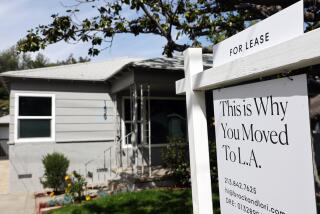How to Cope With the Doubling-Up Monster : Southern California cities need ingenuity--and federal aid
- Share via
Like the old woman who lived in a shoe with so many children she didn’t know what to do, an increasing number of poor and large families are doubling and tripling up in small apartments originally intended for one or two people.
Overcrowding--the federal standard defines it as any unit that houses more than one person per room--has gotten much worse in the last decade. In 1981 the U.S. Department of Housing and Urban Development spent $32.2 billion on low-income housing, including construction of multifamily housing. Federal aid dropped to $18.9 billion the next year and hit a low of $7.9 billion in 1989.
Those cuts were made at the very time that the need was multiplying. More poor renters were competing for fewer affordable apartments because of the huge rise in real estate prices in many urban areas. The competition for cheap housing became even fiercer in Southern California because of immigration. Now, one out of four Latinos lives in overcrowded housing.
Overcrowding is no longer limited to urban slums, and it now burdens roads, sewer systems, schools and other public services in the suburbs. Local leaders are crafting their own solutions that include productive strategies, punitive strategies or a little of both.
INCREASING THE SUPPLY: In Los Angeles, where the overcrowding is so bad that some families live in garages, the City Council recently approved strategies that emphasize expanding the supply of affordable housing through new construction, rehabilitation, preservation and even adding to the square footage of existing units. The approach would also site new housing near major public transportation stops to reduce traffic congestion. To finance these projects, city officials will use $20 million in federal funds, and they have applied for an additional $100 million.
CRACKING DOWN: In Santa Ana, the City Council has passed an ordinance restricting the number of people allowed to live in a one-bedroom apartment to five. If the ordinance holds up in court, violating landlords would be hit with stiff fines. Such a law couldn’t even be contemplated in Los Angeles, where the doubling-up problem is much more severe, without threatening to leave thousands homeless.
In Dana Point, an affluent coastal resort in Orange County, the City Council is scheduled to consider a limit later this month. But, in a step that could relieve some pressure, the council has also instructed the developer of a large hotel, the proposed Monarch Beach Resort, to provide housing assistance to 25% of its new workers. The details have not yet been worked out; however, one option for commercial developers is to consider funding nonprofit developers to build subsidized housing on-site for minimum-wage hotel workers.
Unless more cities capitalize on low-income housing tax credits, somehow squeeze out more federal aid or work with nonprofit developers to soften the housing impact of new commercial development, about the only way to reduce overcrowding is to increase homelessness. And that’s no answer.
More to Read
Sign up for Essential California
The most important California stories and recommendations in your inbox every morning.
You may occasionally receive promotional content from the Los Angeles Times.






